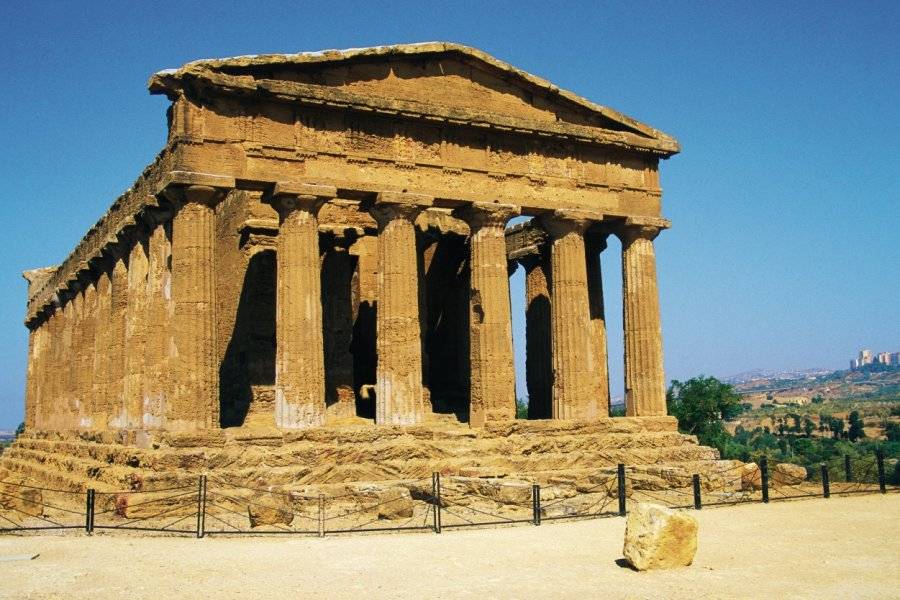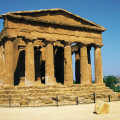Famous Valley of the Temples of Agrigento classified as a World Heritage Site by Unesco.
The ancient city, the famous Valley of the Temples of Agrigento, classified as a world heritage site by Unesco, overlooks the sea with its colonnades still standing. The Greco-Roman temples are beautifully preserved. For centuries, it has been a pilgrimage destination for lovers of ancient Greece and especially for artists. Despite the tourist influx, it is an exceptional site that invites meditation and does not fail to exercise its fascination on visitors. It was Goethe's favorite place for meditation. It takes a minimum of half a day to visit the site properly.
Smart info. There are three ticket offices at the Hellenistic Theater, the Temple of Juno and Gate V to pay for entrance tickets to the archaeological park. If one of them is overcrowded, try another entrance. Coupled tickets with the Valley of the Temples, the archaeological museum of Agrigento or the garden of Kolymbetra are available and are the best way to visit everything. Ask for information before buying your ticket. Remember to take plenty of water, a sandwich if you want to have a picnic around the temples, good shoes and sun cream, it is very hot and shade is rare.
The main temples
Tempio della Concordia. The temple of the Concord, elegant, harmonious and solemn, is one of the most perfect and best preserved Hellenistic temples in the world! Built in 340 BC, it is made of calcarenite, a rock formed by an amalgam of calcareous sands. But it is necessary to imagine that originally this temple of Doric style was entirely covered with white stucco, outside as inside. Some elements were polychrome, like the frieze alternating metopes and triglyphs which surmounts the columns, and its roof was covered with marble tiles. Today we are far from its original colorful appearance! Its classical architecture consists of a peristyle of 34 elegant columns with fluted shafts, namely 13 columns on the long sides and 6 on the shorter sides, which rise on a four-step base. The architects of the ancient world used trompe l'oeil techniques to enhance the monumental appearance of the building. If when approaching the temple its verticality seems perfect, if you look closer you can see that the columns are thinned in their upper parts (on the long sides), so they seem to be taller. To compensate for this, the columns on the shorter sides are slightly tilted towards the interior of the temple. A successful optical illusion!
According to the classical tradition, its plan includes three internal spaces, the cella, the most important room which was often used as a sanctuary, the pronaos, the entrance hall, and the opisthodome, the back part of the temple where offerings or sacred objects could be kept. Note that the interior cannot be visited. However, one can guess its internal architecture by walking around it.
We do not know today to whom this temple was dedicated. It owes its name to the archaeologist Tommaso Fazello who was inspired by a Latin inscription, Concordia, found near the temple, which however has no connection with it. However, two statues were found inside the place of worship, which gave rise to the hypothesis of its attribution to the Dioscuri, Castor and Pollux! Unfortunately, we lack historical elements to be able to affirm it.
Why is the temple of Concord so well preserved? It is thanks to the bishop Gregory who, in the VIth century, transformed the Doric temple into a Christian basilica, event which saved it from a certain destruction by the Christians. Gregory had the two pagan idols of Eber and Raps found in the temple destroyed before dedicating it to the apostles Peter and Paul. The architecture of the temple was modified by a series of arcades that enriched the cella, a reinforcement that favored the conservation of the Temple of Concord. In the western wall, burials were dug to form a paleochristian necropolis. On the east side there were also arcosolium tombs (semicircular niches surmounted by an arch). It was only after the restoration of 1788 that the temple was restored to its ancient form after the removal of the internal additions from the Paleochristian period. Since then, the temple has undergone several restorations.
In front of the Temple of Concord, a contemporary artist has installed a magnificent sculpture of Icarus falling from the sky. Son of the famous architect and inventor Daedalus, he wanted to escape from the labyrinth with wax wings made by his father before flying too close to the sun ... and burning his wings! At night, the temple of the Concord is illuminated and can be seen from far away, majestically enthroned on the Valley of the Temples.
Tempio of Giunone. After its twin, the temple of the Concord, the temple of Juno is certainly the best preserved temple of the Valley, and its dominant position, at 120 meters above the sea on the highest point of the Valley of the Temples, makes it all the more impressive! It is located in a dominant position, isolated on a hillside, at the eastern end of the Valley of the Temples. It was built around 460-450 BC. Its Doric style classical architecture preserves today 25 columns intact for the pleasure of the curious, the amateurs and the historians. Comparable to the Temple of Concord, it originally had 34 columns, 13 on the longer sides and 6 on the shorter sides. 16 of its columns have also preserved their capitals. Imagine that its roof was once covered with marble tiles. Its classical plan consists of an entrance vestibule called pronaos, a central room, the cella, and a rear vestibule, the opisthodome, as tradition dictates. It has the particularity of a later construction of a stepped base in the cella, where red traces have been observed that testify to a fire that historians have associated with the Carthaginian invasions of 406 BC. Its attribution is uncertain, although it is usually called temple of Juno by confusion. To the east, you can see a large altar once dedicated to sacrifices, as well as a piece of road dug by the wheels of the chariots of the time. Behind the temple, archaeologists have also discovered a cistern.
Sanctuario delle Divinita Ctone. These sanctuaries of the chtonian deities are dedicated to Demeter and Persephone. Particularly remarkable: the big circular altar with a well dug in the stone, the bothros, where the animals were sacrificed. It is said that between these stones sometimes resound mysterious songs, coming from the depths of the ages. These voices, which wake up in particular from September 23 to October 22, are linked to the ancient orgiastic and Dionysian cults. Moreover, in the late Roman period, access to this place was forbidden to avoid any overflow. The prohibition is now lifted, and one can at leisure try to perceive these sighs and cries when the zodiac enters the sign of Libra... It is enough, when the night comes, to listen, with the ear placed against the circular part, to perceive clearly these rumors.
Tempio dei Dioscuri (Castore e Polluce). Not far from the sanctuaries rise the ruins of the temple of the Dioscuri or of Castor and Pollux, composed of four columns that support part of the architrave and the pediment. Small among the big ones, it has something very moving.
Tempio di Vuclano. Near the ruins of the temple of the Dioscuri, the temple of Vulcan, dating from the end of the5th century B.C., is located in the most western part of the Valley of the Temples. Of the 34 original columns, only 2 remain. Behind the temple of Zeus is the area of the Roman forum. The Ekklesiasterion, the assembly of the townspeople, is still clearly visible. It has a diameter of 48 m and contained 3,000 places. Of the zones of Greek and Punic dwellings remain only the layout of the streets which separate the foundations of the buildings, some columns, porticoes, some pavements of mosaics, the traces of an immense network of drains. The house of the peristyle is one of the best preserved houses. The necropolis extends to the west of the ancient city.
Tempio di Ercole. At the southern end of the city, two paths leave from the road 118. At the edge of the one on the left, which goes east, there is the hill of the temples, with first the ruins of the temple of Heracles, first of the Doric temples of Agrigento. It dates back to the VIth century B.C. and would be the oldest of the site. Of elongated form, it counted 6 columns in its width and 15 in its length, 10 m high. Today, only 8 columns remain, 4 of which still have their capitals, the bases and the remains of the altar.
Tempio di Zeus Olympios. At the beginning of the road 118, towards the west, we reach the temple of Zeus also called the Olymperion, a huge sacred building in Doric style (6,430square meters), glorified by Diodorus and Polybel, and built in memory of the victory against the Carthaginians in Himera in 408 B.C. This temple is one of the largest that was ever built in antiquity. The two cyclops, once inserted in the middle of the half-columns of the temple as if to support the entablature, have become the symbols of the city. Completely stripped of its sculptures and decorations, the temple of Zeus remained standing until the Middle Ages, then, little by little, over the years, it fell into ruin.
Campo dell'Olympeion. This field of Olympus, located on the other side of the Porta Aurea, is exceptional for its particular ruins. On this esplanade stretch on the ground the remains of a telamon, a gigantic colossus that supported columns of temples, that was also called Atlantean. The sculpture supported the load and was part of the architectural elements as well as decoration. The pieces of the giant puzzle that constitute the ruins do not give a clear idea of the spatial organization of the sanctuary. On the other hand, to the west of this one is another sanctuary in the shape of "L" of which one still admires the paved streets, a chapel and a tholos, a circular building which was probably a tomb.
Did you know? This review was written by our professional authors.
Members' reviews on VALLEY OF THE TEMPLES - PARCO ARCHEOLOGICO
The ratings and reviews below reflect the subjective opinions of members and not the opinion of The Little Witty.



